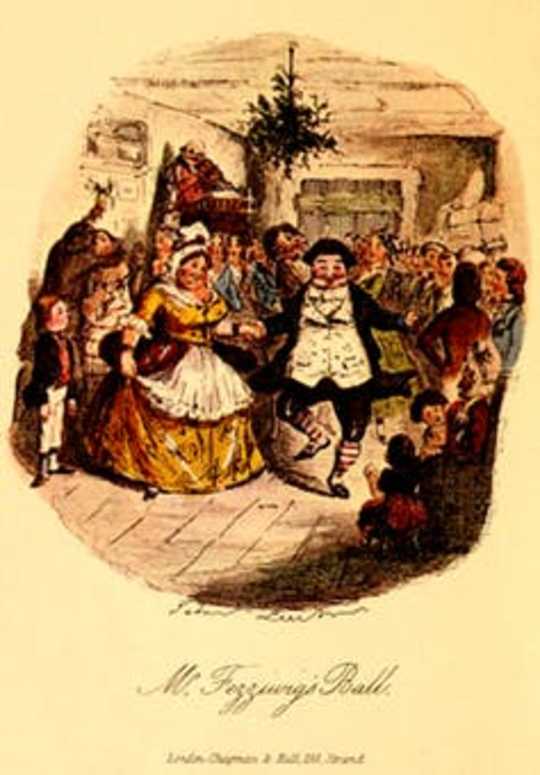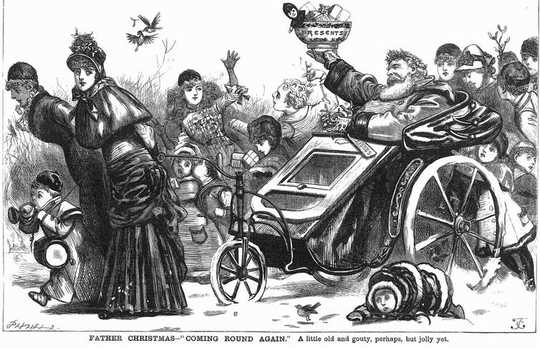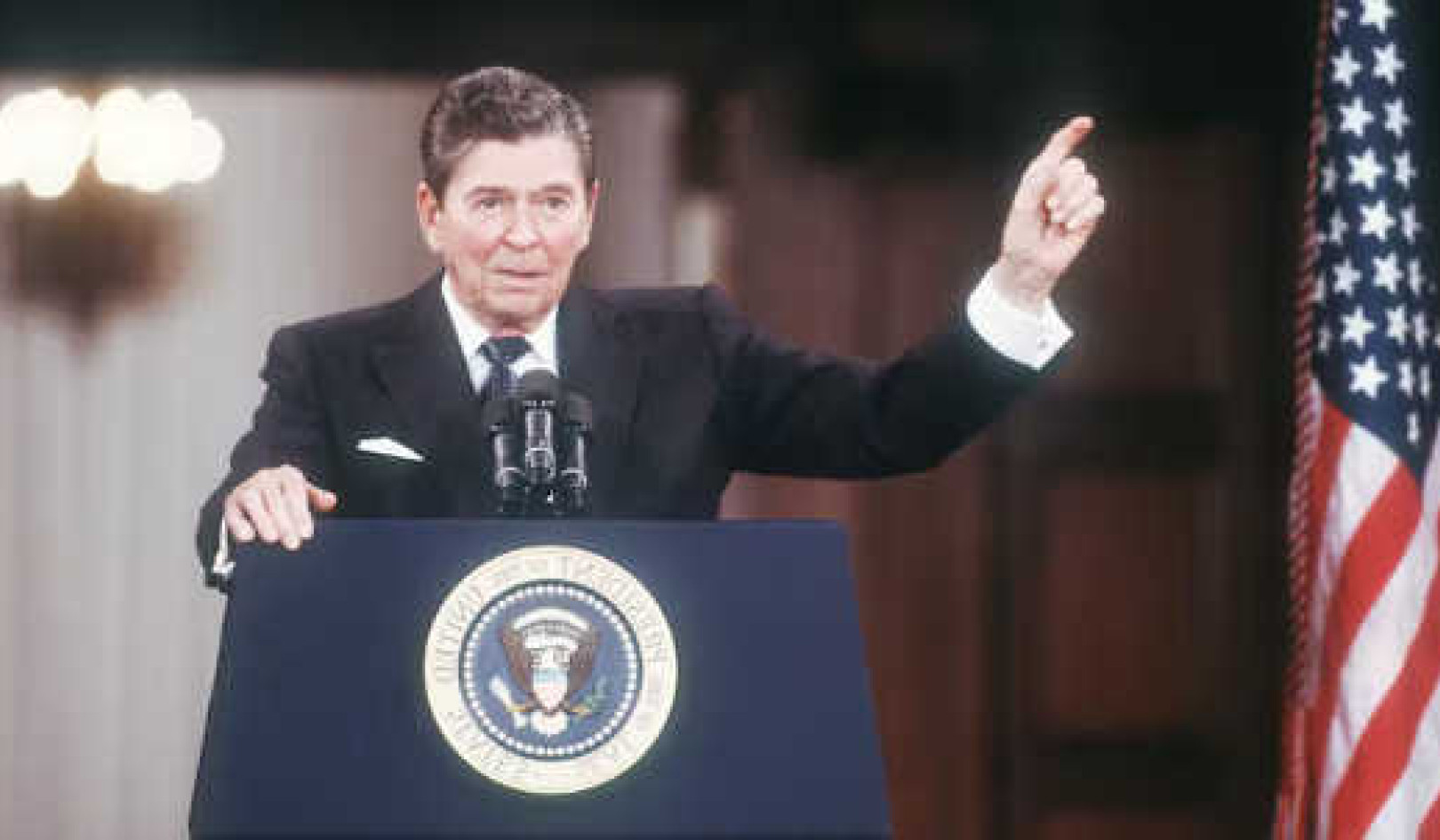 LightField Studios/Shutterstock.com
LightField Studios/Shutterstock.com
December 25, as we all know, is Jesus Christ’s birthday, a Christian celebration in which the myth of three kings who travelled far and wide to give gifts to the “new born king” inspires the modern Christian tradition of gift giving. Early gifts used to be fruits or nuts, but as this act took on more importance, gifts became larger and less modest, and were placed under a tree.
Midwinter has been a period of festivities for millenia, but Christmas as we know it today has its origins in Victorian Britain. It was in Victorian times that the idea of Christmas as a family holiday, with gift giving, a tree, and an intimate dinner became central to this celebration. Britons traditionally celebrate Christ’s birth with a religious mass. Hence the words “Christ” and “mass” coming together to form the word Christmas.
 From A Christmas Carol by Charles Dickens, 1843. Wikimedia Commons
From A Christmas Carol by Charles Dickens, 1843. Wikimedia Commons
Charles Dickens defined the British Christmas with his story, A Christmas Carol, which linked Christian values with the idea of sharing and a “festive generosity of spirit”. His book helped popularise what was already occurring in Britain, and is credited with spreading the traditions of the festival. His book sold out in its first printing in 1843 and set the tone for the mid-Victorian revival of the Christmas holiday by reflecting and reinforcing the Dickensian vision of Christmas.
An early English folkloric tradition associated with this holiday celebration is “Old Father Christmas”, who can first be found in the mid-17th century as a symbol of good cheer. In the early part of the 19th century, he was depicted as a skinny man who promoted drinking and partying during the holiday season. But by 1874, Father Christmas had evolved into a round jolly man wearing red and green fur lined robes and holly on his head.
This early version of Father Christmas was mostly associated with the adult celebration, but during the Victorian times with their new focus on the family, Father Christmas began to be linked to the idea of giving gifts. Images of Christmas were reproduced in popular culture through mass mediums of newspapers; magazines and theatre. These images visually defined Christmas and how it should be celebrated.
 Father Christmas in 1879, with holly crown and wassail bowl used for the delivery of children’s presents. 'Fun' (London, England), Issue 763, p 256.
Father Christmas in 1879, with holly crown and wassail bowl used for the delivery of children’s presents. 'Fun' (London, England), Issue 763, p 256.
By the 20th century, mass advertising became commonplace. Consumer messages were now broadcast to the public through billboards, magazines, radio, and later the moving image of television. Mass advertising was what allowed the slowly developing idea of Christmas as a time to give gifts to go mainstream, and eventually, to define Christmas itself.
Businesses realised that Christmas could be a brilliant money spinner. Seasonal advertisements began to emphasise the act of “giving gifts” as a major part of Christmas time by having Father Christmas physically display branded products to a growing consumer market. The link between this Christmas icon and consumer goods was made very obvious in advertising, as illustrated in this ad from Newball & Mason to sell an assortment of alcoholic spirits. Advertising took the fable of Father Christmas and linked him with physical brands, turning myth into a reality, something that could be touched, smelled, and experienced.
In 1937 Coca Cola introduced the world to a simplified and more accessible version of Father Christmas dressed in Coca-Cola red, this time without the traditional cape. In their ads he was named Santa Claus, in accordance with American tradition. Santa Claus became a personification of the brand and gave the brown liquid a personality and a face, associating the drink with one of the happiest yearly western celebrations. Coke repeated the same message every December, and the name “Santa” slowly replaced “Father Christmas” in popular parlance in the UK too. This led to the red suited man becoming the icon most associated with Christmas.
Coca Cola’s Christmas ads are still going strong.
{vembed Y=lTev1oQntx0}
In Britain, brands continued to express the idea reflected by Dickens that Christmas was a time to celebrate and unite the family. Queen Victoria and Albert celebrated with a Christmas tree, and slowly the concept of putting presents under a decorated tree took hold. In the 20th century the idea of Father Christmas bringing presents and leaving them under the tree became popular, thereby linking the concept of Santa delivering presents with the joy of sharing.
One 1965 ad selling tape recorders, for example, shows a white British family opening presents on a Christmas morning recording a child playing on his new drum. This image attempts to convince the consumer that they can demonstrate “love” through the act of giving gifts, an idea that still has real traction today.
Modern Christmas advertising has moved on again in order to reflect our multicultural and ever more secular societies. In the latest Selfridges television ad, “A Christmas for Modern Times”, a multiracial group of friends are shown celebrating “future fantasy” of Christmas. This “chosen family” share gifts, food and drink with one another, and then go dancing in a nightclub. The addition of going to a disco to continue the Christmas celebration reflects ever newer forms of cheer and highlights just how far the idea of Christmas is now removed from religion.
{vembed Y=VbnjObIsfsE}
Thankfully, the white nuclear family casts are now, mostly, consigned to historical Christmas ads. The 2019 John Lewis ad “Excitable Edgar” and Ikea’s #WonderfulEveryday both feature multiracial casts celebrating Christmas together. These visual representations of Christmas signpost the holiday’s evolution from a white one to an inclusive one. Christmas is no longer a Christian holiday – but a time to be celebrated by everyone.
This is of course something we should be thankful for – but now that it has been replaced by a religion of conspicuous consumption, it’s big business which will be most pleased of all.![]()
About The Author
Carl W. Jones, Senior Lecturer, School of Media and Communication, University of Westminster
This article is republished from The Conversation under a Creative Commons license. Read the original article.
Recommended books:
Capital in the Twenty-First Century
by Thomas Piketty. (Translated by Arthur Goldhammer)
 In Capital in the Twenty-First Century, Thomas Piketty analyzes a unique collection of data from twenty countries, ranging as far back as the eighteenth century, to uncover key economic and social patterns. But economic trends are not acts of God. Political action has curbed dangerous inequalities in the past, says Thomas Piketty, and may do so again. A work of extraordinary ambition, originality, and rigor, Capital in the Twenty-First Century reorients our understanding of economic history and confronts us with sobering lessons for today. His findings will transform debate and set the agenda for the next generation of thought about wealth and inequality.
In Capital in the Twenty-First Century, Thomas Piketty analyzes a unique collection of data from twenty countries, ranging as far back as the eighteenth century, to uncover key economic and social patterns. But economic trends are not acts of God. Political action has curbed dangerous inequalities in the past, says Thomas Piketty, and may do so again. A work of extraordinary ambition, originality, and rigor, Capital in the Twenty-First Century reorients our understanding of economic history and confronts us with sobering lessons for today. His findings will transform debate and set the agenda for the next generation of thought about wealth and inequality.
Click here for more info and/or to order this book on Amazon.
Nature's Fortune: How Business and Society Thrive by Investing in Nature
by Mark R. Tercek and Jonathan S. Adams.
 What is nature worth? The answer to this question—which traditionally has been framed in environmental terms—is revolutionizing the way we do business. In Nature’s Fortune, Mark Tercek, CEO of The Nature Conservancy and former investment banker, and science writer Jonathan Adams argue that nature is not only the foundation of human well-being, but also the smartest commercial investment any business or government can make. The forests, floodplains, and oyster reefs often seen simply as raw materials or as obstacles to be cleared in the name of progress are, in fact as important to our future prosperity as technology or law or business innovation. Nature’s Fortune offers an essential guide to the world’s economic—and environmental—well-being.
What is nature worth? The answer to this question—which traditionally has been framed in environmental terms—is revolutionizing the way we do business. In Nature’s Fortune, Mark Tercek, CEO of The Nature Conservancy and former investment banker, and science writer Jonathan Adams argue that nature is not only the foundation of human well-being, but also the smartest commercial investment any business or government can make. The forests, floodplains, and oyster reefs often seen simply as raw materials or as obstacles to be cleared in the name of progress are, in fact as important to our future prosperity as technology or law or business innovation. Nature’s Fortune offers an essential guide to the world’s economic—and environmental—well-being.
Click here for more info and/or to order this book on Amazon.
Beyond Outrage: What has gone wrong with our economy and our democracy, and how to fix it -- by Robert B. Reich
 In this timely book, Robert B. Reich argues that nothing good happens in Washington unless citizens are energized and organized to make sure Washington acts in the public good. The first step is to see the big picture. Beyond Outrage connects the dots, showing why the increasing share of income and wealth going to the top has hobbled jobs and growth for everyone else, undermining our democracy; caused Americans to become increasingly cynical about public life; and turned many Americans against one another. He also explains why the proposals of the “regressive right” are dead wrong and provides a clear roadmap of what must be done instead. Here’s a plan for action for everyone who cares about the future of America.
In this timely book, Robert B. Reich argues that nothing good happens in Washington unless citizens are energized and organized to make sure Washington acts in the public good. The first step is to see the big picture. Beyond Outrage connects the dots, showing why the increasing share of income and wealth going to the top has hobbled jobs and growth for everyone else, undermining our democracy; caused Americans to become increasingly cynical about public life; and turned many Americans against one another. He also explains why the proposals of the “regressive right” are dead wrong and provides a clear roadmap of what must be done instead. Here’s a plan for action for everyone who cares about the future of America.
Click here for more info or to order this book on Amazon.
This Changes Everything: Occupy Wall Street and the 99% Movement
by Sarah van Gelder and staff of YES! Magazine.
 This Changes Everything shows how the Occupy movement is shifting the way people view themselves and the world, the kind of society they believe is possible, and their own involvement in creating a society that works for the 99% rather than just the 1%. Attempts to pigeonhole this decentralized, fast-evolving movement have led to confusion and misperception. In this volume, the editors of YES! Magazine bring together voices from inside and outside the protests to convey the issues, possibilities, and personalities associated with the Occupy Wall Street movement. This book features contributions from Naomi Klein, David Korten, Rebecca Solnit, Ralph Nader, and others, as well as Occupy activists who were there from the beginning.
This Changes Everything shows how the Occupy movement is shifting the way people view themselves and the world, the kind of society they believe is possible, and their own involvement in creating a society that works for the 99% rather than just the 1%. Attempts to pigeonhole this decentralized, fast-evolving movement have led to confusion and misperception. In this volume, the editors of YES! Magazine bring together voices from inside and outside the protests to convey the issues, possibilities, and personalities associated with the Occupy Wall Street movement. This book features contributions from Naomi Klein, David Korten, Rebecca Solnit, Ralph Nader, and others, as well as Occupy activists who were there from the beginning.
Click here for more info and/or to order this book on Amazon.























